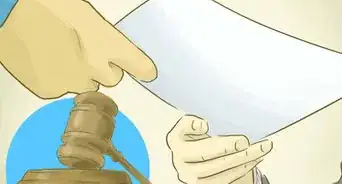This article was written by Jennifer Mueller, JD. Jennifer Mueller is an in-house legal expert at wikiHow. Jennifer reviews, fact-checks, and evaluates wikiHow's legal content to ensure thoroughness and accuracy. She received her JD from Indiana University Maurer School of Law in 2006.
This article has been viewed 75,276 times.
The state of Indiana calls divorce "dissolution of marriage," but it means the same thing.[1] You can file for divorce if you've been living in the state for at least six months and living in the county where you file for at least three months.[2] The forms and procedure for getting a divorce vary based on whether you and your spouse have children together, and whether you and your spouse agree on all the issues in your case.[3] Although you can file for divorce on your own, getting an attorney is highly recommended. If you go it alone, you'll be expected to follow the same rules attorneys follow – even if you don't know them. If money is a factor, you can contact your local bar association or a legal aid clinic to find free or reduced-cost services.[4]
Steps
Filing for Divorce without Children and without an Agreement
-
1Make sure you qualify to use the self-service packet. The Indiana courts provide fill-in-the-blank forms you can use to file for divorce without an attorney, even if you and your spouse do not agree on the division of debts and property. To use these forms, you cannot have any biological or adopted minor children with your spouse.
-
2Download the packet and instructions. Forms, along with instructions for filling them out, can be found online. You also can find hard copies in the clerk's office of your local courthouse.Advertisement
-
3Complete your divorce forms. In the packet you'll find eight forms that you'll need to fill out to get a divorce. The packet also includes a document with detailed instructions on how to fill out each form line by line.
- You can fill in the blanks on the form directly on your computer, or you can print up the forms and write in your information by hand.
- The Appearance by Unrepresented Person in Civil Case announces to the court that you want to participate in a civil suit and that you don't have an attorney. Since you have contested issues in your case, you might want to consider hiring an attorney to represent you in court. This is all the more important if your spouse has already hired or plans to hire an attorney.
- The Verified Petition for Dissolution of Marriage asks the court to grant you a divorce. Since you haven't agreed on your division of property, the petition asks the court to make temporary arrangements until the case is over.
- The Summons notifies your spouse that you've filed for divorce and lets him know that if he wants to participate he'll have to file an appearance as well.
- The Notice of Provisional Hearing notifies your spouse and any other parties of the date of your provisional hearing.
- The Temporary Order outlines any temporary arrangements the judge has approved for housing or taking care of property while the case is ongoing.
- The Motion for Final Hearing asks the court to set a date for a hearing to finalize the divorce and division of property.
- The Notice of Final Hearing alerts your spouse and any other parties to the date of the hearing.
- The Decree of Dissolution of Marriage is the court's final order ending the marriage and outlining the division of debts and property.
-
4Print and make copies of your forms. Once you've completed all your forms, you'll need to print several copies of each one to prepare for filing. Check your local rules to find out exactly how many copies of each document you must have.
- Because court records are available to the public by law, Indiana courts provides a form printed on light green paper where you need to enter any confidential information such as Social Security or bank account numbers to protect your privacy. This information will be filed with your case but won't be released to the public. However, since you don't have any children, you shouldn't need a green form.
-
5Sign your forms. As the person filing for a divorce, you need to sign each form in the blank for the "petitioner."
-
6File your initial forms in your county court clerk's office. Some forms will be filed later, and others you'll need to present to the judge during your hearing. For now, you need to file your appearance, verified petition, summons, and notice of provisional hearing.
- The clerk will charge you a filing fee ranging from $132 to $152. The fee varies from county to county.[5] If you can't afford the fees, fill out the form for a fee waiver and file it with the clerk as well.
- Once you've paid, the clerk will give you a case number and process your forms by stamping them with the filing date.
-
7Serve your spouse. You must send your spouse, or his attorney if he has one, a copy of the file-stamped appearance, petition, summons, and request for provisional hearing. The easiest way to do this is to send him copies using certified mail.
- You can also complete service by hiring someone from a private process serving company or by contacting the Sheriff's office.
- Different counties have different preferred methods of service, so ask the clerk what would be the best way for you to do this.
-
8Receive notice of your provisional hearing. Since you requested a provisional hearing, the court will mail you and your spouse a notice with the date and time when your hearing is scheduled.
-
9Attend your provisional hearing. Since you and your spouse haven't come to an agreement on the division of your property, the provisional hearing allows the judge to issue temporary orders that will be in place until the divorce is finalized.
- Both you and your spouse will attend the hearing and may present evidence and testimony on your behalf.
- When you go to the hearing, bring along your original and copies of the temporary order you filled out as part of the packet.
-
10File your final forms. Once 60 days have elapsed following your initial filing, go back to the clerk's office and file your motion for final hearing and your notice of final hearing. The clerk will file-stamp your documents.
-
11Serve your spouse. As with your initial filing, you must serve your spouse a copy of your motion. You should serve the motion the same way you served the initial filing, whether you used a process server or certified mail.
-
12Receive notice of your final hearing. Once your final hearing is put on the court's docket, the court will mail both you and your spouse a notice of the date, time, and location of your final hearing.
-
13Attend your final hearing. Take all of your documents and any evidence you want to present as well as your decree of dissolution.
- Arrive early and dress in clean, conservative attire. Turn off your cell phone or other electronic devices and treat all court staff politely and with respect.
- As the petitioner, you will get to speak first. Answer any questions the judge asks you, but don't interrupt her or talk over her. Keep your statements brief and try to stick to the facts. Address the judge rather than speaking to your spouse.
- After you speak, your spouse will have an opportunity to present his side of the issue. Don't interrupt him, talk over him, or attempt to argue with him. If he mentions anything that the judge wants you to clarify, she will ask you to do so.
-
14Receive your final decree. Sometimes the judge will make her decision on the spot, but you may have to wait for your final decree to come in the mail. The judge may simply sign the decree you drafted and brought with you, but she also may decide to write her own.
Filing for Divorce without Children but with an Agreement
-
1Make sure you qualify to use the self-service packet. You can use the packet of self-service forms provided by the Indiana state courts if you and your spouse don't have any biological or adopted children and you have an agreement on how you will divide your debts and property.
-
2Download the packet and instructions. The forms and instructions are available online. You also can pick up paper versions of the same forms at the clerk's office in your local courthouse.
-
3Complete your divorce forms. The packet includes five forms that you must fill out to ask the court for a divorce. Detailed instructions on how to fill out each form are included in the packet.
- You can type the information directly into the forms, or you can print them and write in the information required with a black ink pen.
- The Appearance by Unrepresented Person in Civil Case form lets the court know that you want to start a civil case and you don't have an attorney.
- The Verified Petition for Dissolution of Marriage and Agreement sets forth the agreement you and your spouse have made, and asks the court to approve that agreement and grant you a divorce.
- The Summons notifies your spouse that you've filed for divorce and that he will have to file an appearance as well if he wants to participate in the case.
- The Verified Waiver of Final Hearing lets the court know that since you and your spouse agree to all the terms of the divorce you've waived your right to a final hearing.
- The Decree of Dissolution of Marriage is the final order the judge will sign that will formally end your marriage and outline your agreement regarding issues such as division of property and child custody.
-
4Print and make copies of your forms. Once you've added the correct information according to the instructions provided, print the completed forms. Contact your court clerk or review your local rules to find out how many copies you should make or if your court requires any additional forms.
- A light green form is available for any confidential information, such as Social Security numbers, so that information does not become part of the public record of your case. Since you don't have any children, you shouldn't need to file a green form at all.
-
5Sign your forms. Since you're opening the case, you'll sign each of the forms you've filled out in the blank for "petitioner."
-
6File your initial forms in your county court clerk's office. To start your case, you'll need to take the originals plus all copies of your appearance, verified petition, and summons to the clerk's office.
- The clerk will charge you a filing fee ranging from $132 to $152. The fee varies from county to county.[6] If you can't afford the fees, fill out the form for a fee waiver and file it with the clerk as well.
- Once you've paid, the clerk will give you a case number and process your forms by stamping them with the filing date.
-
7Serve your spouse. You must send your spouse, or his attorney if he has one, a copy of your file-stamped forms. The easiest way to do this is to send him copies using certified mail.
- You can also complete service by hiring someone from a private process serving company or by contacting the Sheriff's office.
- Different counties have different preferred methods of service, so ask the clerk what would be the best way for you to do this.
-
8Wait 60 days. Indiana judges can enter temporary orders, but they cannot finalize a divorce until at least 60 days after the initial petition was filed. If the court is really busy, you may have to wait longer than that.[7]
-
9File your final forms in your county court clerk's office. After the waiting period, take the originals and the copies of your completed and signed waiver of final hearing and decree of dissolution and file them with the clerk. The clerk will forward the decree to the judge to sign.
- You need to bring at least three copies of the decree along with two pre-addressed stamped envelopes. When the judge signs the decree, one copy will remain at the court, while one will be sent to you and the other to your spouse.
-
10Receive your Decree of Dissolution. Since you waived your final hearing, you'll receive your decree in the mail after the judge has signed it.
Filing for Divorce with Children but without an Agreement
-
1Make sure you qualify to use the self-service packet. Indiana has fill-in-the-blank forms available for spouses who want to file for divorce but don't want to hire an attorney. This packet contains forms for couples with biological or adopted children who haven't been able to come to an agreement about child custody and support issues or about the division of marital property. Be aware that family law is complicated, and hiring an attorney is recommended, especially if there are contested issues in your case. If you represent yourself you will be expected to follow the same rules attorneys do. [8]
-
2
-
3Complete your divorce forms. The packet includes nine forms that you'll have to fill out to start your case and request the court grant you a divorce.
- You can either fill out the forms on your computer by typing in your information, or write the information out by hand on the paper copies.[10]
- The Appearance by Unrepresented Person in Civil Case tells the court who you are and that you want to participate in a civil case without an attorney.
- The Confidential form provides a place for you to let the court know information such as Social Security numbers or financial account numbers without them being a matter of public record.
- The Verified Petition for Dissolution of Marriage is the form where you ask the court to grant you a divorce, and also to make any necessary temporary arrangements until the divorce is finalized.
- The Summons tells your spouse that you've filed for divorce and that he should file an appearance if he wants to participate in the case.
- The Notice of Provisional Hearing will notify your spouse and any other parties of the date, time, and location of the provisional hearing in your case.
- The Temporary Order will be signed by the judge and will list temporary arrangements for matters such as child custody and housing until the divorce is finalized.
- The Motion for Final Hearing asks the court to set a hearing to end your marriage and finalize your parenting arrangements and property division.
- The Notice of Final Hearing alerts your spouse and any other parties of the date, time, and location the final hearing in your case.
- The Decree of Dissolution of Marriage is the judge's final order in your case dissolving your marriage and outlining the division of property, child custody and visitation, and child support.
-
4Complete your child support forms. You must complete the Child Support Obligation Worksheet and take it with you to your provisional hearing.
- To fill out the worksheet, you'll need to use Indiana's child support calculator at http://mycourts.in.gov/csc/parents/. The calculator is based on the Indiana Child Support Guidelines, which you should read thoroughly.
- The child support obligation worksheet is the only one that's required. However, you also will need to fill out the other worksheets, such as the parenting time credit worksheet, if they are applicable to your situation.
-
5Print and make copies of your forms. After you've completed your forms, you'll need the originals and at least two copies – one for you and one for your spouse. Check your local rules to see if your court requires any more copies.
-
6Sign your forms. Since you're opening the case, you'll sign each of the forms you've filled out in the blank for "petitioner."
-
7File your initial forms in your county court clerk's office. To start your case, you'll need to take the originals plus all copies of your appearance, confidential form, verified petition, summons, and notice of provisional hearing to the clerk's office.
- You'll have to pay a filing fee between $132 to $152 depending on the county where you live.[11] If you can't afford the fee, you can fill out and file a form with the court to apply for a fee waiver.
- Once you've paid, the clerk will give you a case number and process your forms by stamping them with the filing date.
-
8Serve your spouse. You must send your spouse, or his attorney if he has one, a copy of your file-stamped forms. If your spouse has an attorney, it would probably be in your best interest to hire your own, especially considering there are contested issues in your case.
- You can complete service by hiring someone from a private process serving company or by contacting the Sheriff's office, but typically you would send them using certified mail.
- Different counties have different preferred methods of service, so ask the clerk what would be the best way for you to do this.
-
9Receive notice of your provisional hearing. The court will mail you and your spouse a notice with the date, time, and location of your provisional hearing.
-
10Attend your provisional hearing. You and your spouse have an opportunity to present evidence and testimony in favor of the temporary arrangements you want the judge to order while the divorce case is ongoing. These temporary arrangements will be legally binding until the divorce is finalized.
- Bring originals and copies of your temporary order and your child support obligation worksheet. You also should have originals and copies of your parenting time credit worksheet, your health insurance premium worksheet, or your post-secondary education worksheet, if any of those are applicable to your case.
- Keep in mind that the amount of money the worksheet produces isn't necessarily the specific amount you or your spouse will be obligated to pay. The worksheet is based on the information you entered, but the judge has discretion to raise or lower that amount in the best interests of the child, depending on other factors or circumstances.
-
11Make your final filing. You have to wait 60 days after your initial filing, but then you can return to the clerk's office and file your motion for final hearing and notice of final hearing. The clerk will file-stamp your originals and copies.
-
12Serve your spouse. Just as you did with your initial filing, you must serve your spouse with copies of your motion for final hearing.
-
13Receive notice of your final hearing. When the court places your case on the docket, you and your spouse will receive a notice of the date, time, and location of your final hearing.
-
14Attend your final hearing. Take all of your documents and any evidence you want to present as well as your decree of dissolution, your child support obligation worksheets, and any other child support forms you had to fill out.
- Arrive early and dress in clean, conservative attire. Turn off your cell phone or other electronic devices and treat all court staff politely and with respect.
- As the petitioner, you will get to speak first. Answer any questions the judge asks you, but don't interrupt her or talk over her. Keep your statements brief and try to stick to the facts. Address the judge rather than speaking to your spouse.
- After you speak, your spouse will have an opportunity to present his side of the issue. Don't interrupt him, talk over him, or attempt to argue with him. If he mentions anything that the judge wants you to clarify, she will ask you to do so.
-
15Receive your final decree. Sometimes the judge will make her decision on the spot, but you may have to wait for your final decree to come in the mail. The judge may simply sign the decree you drafted and brought with you, but she also may decide to write her own.
-
16Receive your final decree. The court will mail final decrees to you and your spouse within a few weeks of your final hearing. If several weeks have passed and you still haven't received your decree, call the clerk's office and ask for a copy.
Filing for Divorce with Children and with an Agreement
-
1Make sure you qualify to use the self-service packet. The Indiana courts make this packet of forms available for married couples with biological or adopted minor children who want to divorce, provided they have already made an agreement on custody and parenting time of their children and the division of all debts and property.[12]
-
2Download the packet and instructions. The forms and instructions are available online, or you can get print copies of the same forms at your county court clerk's office.
-
3Complete your divorce forms. The packet includes six forms that you must fill out to ask the court for a divorce. Detailed instructions on how to fill out each form are included in the packet.[13]
- You can type the information directly into the forms, or you can print them and write in the information required with a black ink pen.
- The Appearance by Unrepresented Person in Civil Case form lets the court know that you want to start a civil case and you don't have an attorney.
- The Confidential Form is where you put all your confidential information such as Social Security numbers. This information will not be part of the public record of your case.
- The Verified Petition for Dissolution of Marriage and Agreement sets forth the agreement you and your spouse have made, and asks the court to approve that agreement and grant you a divorce.
- The Summons notifies your spouse that you've filed for divorce and that he will have to file an appearance as well if he wants to participate in the case.
- The Verified Waiver of Final Hearing lets the court know that since you and your spouse agree to all the terms of the divorce you've waived your right to a final hearing.
- The Decree of Dissolution of Marriage is the final order the judge will sign that will formally end your marriage and outline your agreement regarding issues such as division of property and child custody.[14]
-
4Complete your child support forms. You must complete the Child Support Obligation Worksheet before you can complete the corresponding section of your agreement.
- To fill out the worksheet, you'll need to use Indiana's child support calculator at http://mycourts.in.gov/csc/parents/.
-
5Print and make copies of your forms. Since court records are available to the public by law, Indiana provides a separate document where you can write down any confidential information that is necessary to your case.
- Information such as Social Security numbers, bank account numbers, other financial account numbers, or medical records should be included on this form and not on any of the other papers you file with the court.
- The confidential form is always printed on green paper to alert court staff that it cannot be released to the public even if it's part of the case file as a whole.
- The rest of the forms in the packet should be printed on white paper. Check your local rules to see how many copies of each document you need and whether there are any other forms required for your county court.
-
6Sign your forms. Sign each of your forms in the blanks provided. Since you are the one filing the forms, you'll sign each document everywhere it leaves a blank for the petitioner.
- Indiana does not require you to sign your documents in the presence of a notary or any other witnesses.
-
7File your initial forms in your county court clerk's office. To open your case, you'll need to take the originals and copies of your appearance, confidential form, verified petition, and summons.
- You'll have to pay a filing fee ranging from $132 to $152 depending on the county where you live.[15] If you can't afford the fee, you can fill out and file a form with the court to apply for a fee waiver.
- Once you've paid, the clerk will give you a case number and process your forms by stamping them with the filing date.
-
8Serve your spouse. You must send your spouse, or his attorney if he has one, a copy of your file-stamped forms. Typically you would mail the forms using certified mail.
- You can also complete service by hiring someone from a private process serving company or by contacting the Sheriff's office.
- Different counties have different preferred methods of service, so ask the clerk what would be the best way for you to do this.
-
9Wait 60 days. Indiana judges can enter temporary orders, but they cannot finalize a divorce until at least 60 days after the initial petition was filed. Depending on how busy the judge assigned to your case is, you may have to wait longer than that.[16]
-
10File your final forms in your county court clerk's office. After the waiting period, take originals and copies of your final hearing waiver and decree of dissolution and file them with the clerk. The clerk will forward the decree to the judge to sign.
- You need to bring at least three copies of the decree along with two pre-addressed stamped envelopes. When the judge signs the decree, one copy will remain at the court, while one will be sent to you and the other to your spouse.
-
11Receive your Decree of Dissolution. Since you waived your final hearing, you'll receive your decree in the mail after the judge has signed it.
Warnings
- If you need a protective order, you must file for that separately from divorce. You can pick up a form from the clerk's office.⧼thumbs_response⧽
- Once the divorce is finalized, you generally cannot go back and change anything in the order relating to property and debts. Indiana courts may change orders concerning child support or child custody and visitation in certain circumstances.[17]⧼thumbs_response⧽
- If your spouse is on active duty in the military, the process may take longer. Federal law allows military members to request courts delay court proceedings while they are unavailable because of active duty.[18]⧼thumbs_response⧽
- If either you or your spouse is in the military or is pregnant, you cannot use any of Indiana's self-service forms to get a divorce, even if you have full agreement on all the issues in your case. In these special circumstances you should consult an attorney.[19]⧼thumbs_response⧽
References
- ↑ http://www.divorcenet.com/resources/filing-for-divorce/indiana.htm
- ↑ http://www.indianalegalservices.org/node/5/general-information-about-divorce
- ↑ http://www.in.gov/judiciary/selfservice/2486.htm
- ↑ http://www.indianalegalservices.org/node/5/general-information-about-divorce
- ↑ http://www.indianalegalservices.org/node/5/general-information-about-divorce
- ↑ http://www.indianalegalservices.org/node/5/general-information-about-divorce
- ↑ http://www.indianalegalservices.org/node/5/general-information-about-divorce
- ↑ http://www.in.gov/judiciary/selfservice/2350.htm
- ↑ http://www.in.gov/judiciary/selfservice/2350.htm
- ↑ http://www.in.gov/judiciary/selfservice/2350.htm
- ↑ http://www.indianalegalservices.org/node/5/general-information-about-divorce
- ↑ http://www.in.gov/judiciary/selfservice/2351.htm
- ↑ http://www.in.gov/judiciary/selfservice/2351.htm
- ↑ http://www.in.gov/judiciary/selfservice/2351.htm
- ↑ http://www.indianalegalservices.org/node/5/general-information-about-divorce
- ↑ http://www.indianalegalservices.org/node/5/general-information-about-divorce
- ↑ http://www.indianalegalservices.org/node/5/general-information-about-divorce
- ↑ http://www.indianalegalservices.org/node/5/general-information-about-divorce
- ↑ http://www.in.gov/judiciary/selfservice/2351.htm



























































